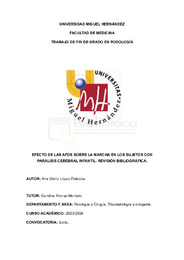Por favor, use este identificador para citar o enlazar este ítem:
https://hdl.handle.net/11000/33314Registro completo de metadatos
| Campo DC | Valor | Lengua/Idioma |
|---|---|---|
| dc.contributor.advisor | Alonso Montero, Carolina | - |
| dc.contributor.author | López Palacios, Ana María | - |
| dc.contributor.other | Departamentos de la UMH::Patología y Cirugía | es_ES |
| dc.date.accessioned | 2024-09-27T08:10:45Z | - |
| dc.date.available | 2024-09-27T08:10:45Z | - |
| dc.date.created | 2024-07-01 | - |
| dc.identifier.uri | https://hdl.handle.net/11000/33314 | - |
| dc.description.abstract | La parálisis cerebral infantil (PCI) es un trastorno neurológico que afecta el movimiento y la postura, resultando en limitaciones significativas en la movilidad y la calidad de vida de los niños afectados. Objetivos: El estudio busca evaluar la mejora de la marcha en niños con PCI mediante el uso de una ortesis tobillo-pie. Material y método: Se realizó una búsqueda exhaustiva en diversas bases de datos: PubMed, Scopus y Web of Science entre octubre de 2023 y enero de 2024, utilizando palabras clave (ortesis, pie, marcha, parálisis cerebral y niño). Además, se aplicaron los criterios de inclusión y exclusión. Resultados: Se encontró que las AFOs mejoran la función motora gruesa y la calidad de la marcha, aumentando la longitud de zancada. Se ha encontrado que reducen el coste de energía en la marcha y una disminución de la flexión plantar del tobillo. En términos cinemáticos, aumentaron la flexión dorsal de tobillo. La rigidez de la AFO principalmente afecta la cinemática del tobillo y la rodilla. En pacientes con equino, promueven una mayor flexión dorsal del tobillo en el contacto inicial, aunque pueden limitar el rango de movimiento de flexión del tobillo. Conclusiones: El uso de ortesis tobillo-pie mejora la marcha en pacientes con parálisis cerebral, aumentando la estabilidad y la autonomía, siendo clave seleccionar adecuadamente el tipo y la rigidez para optimizar los resultados. | es_ES |
| dc.description.abstract | Infantile cerebral palsy (CPI) is a neurological disorder that affects movement and posture, resulting in significant limitations in mobility and quality of life for affected children. Objectives: The study seeks to evaluate the improvement of walking in children with PCI through the use of an ankle-foot orthosis. Material and method: An exhaustive search was carried out in various databases: PubMed, Scopus and Web of Science between October 2023 and January 2024, using keywords (orthosis, foot, gait, cerebral palsy and child). In addition, the inclusion and exclusion criteria were applied. Results: AFOs were found to improve gross motor function and gait quality by increasing stride length. They have been found to reduce the energy cost of walking and plantar flexion. In kinematic terms, they increased ankle dorsiflexion. The stiffness of the AFO mainly affects the kinematics of the ankle and knee. In equinus patients, they promote greater ankle dorsiflexion at initial contact, although they may limit ankle flexion range of motion. Conclusions: The use of ankle-foot orthoses improves gait in patients with cerebral palsy, increasing stability and autonomy, being key to properly select the type and stiffness to optimize results. | es_ES |
| dc.format | application/pdf | es_ES |
| dc.format.extent | 28 | es_ES |
| dc.language.iso | spa | es_ES |
| dc.publisher | Universidad Miguel Hernández | es_ES |
| dc.rights | info:eu-repo/semantics/openAccess | es_ES |
| dc.rights | Attribution-NonCommercial-NoDerivatives 4.0 Internacional | * |
| dc.rights.uri | http://creativecommons.org/licenses/by-nc-nd/4.0/ | * |
| dc.subject | ortesis | es_ES |
| dc.subject | pie | es_ES |
| dc.subject | marcha | es_ES |
| dc.subject | parálisis cerebral | es_ES |
| dc.subject | niño | es_ES |
| dc.subject.other | CDU::6 - Ciencias aplicadas | es_ES |
| dc.title | Efecto de las AFOS sobre la marcha en los sujetos con parálisis cerebral infantil. Revisión bibliográfica | es_ES |
| dc.type | info:eu-repo/semantics/bachelorThesis | es_ES |

Ver/Abrir:
1738-LÓPEZ PALACIOS, ANA MARÍA.pdf
741,3 kB
Adobe PDF
Compartir:
 La licencia se describe como: Atribución-NonComercial-NoDerivada 4.0 Internacional.
La licencia se describe como: Atribución-NonComercial-NoDerivada 4.0 Internacional.
.png)